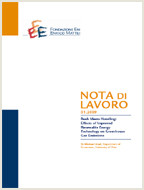Are Democrats Greener than Republicans? The Case of California Air Quality

19.12.2012
Y.H. Farzin and C.A. Bond
Q51, Q58, D78
Political Party Affiliation, Environmental Regulation, Air Pollution
Climate Change and Sustainable Development
Carlo Carraro
When it comes to environmental quality preferences, it is popularly believed that Democrats (and more generally, liberals) are “green” while Republicans” (conservatives) are “brown”. Does empirical evidence support this popular belief? We test the hypothesis that regional political identification leads to differences in concentration outcomes for several measures of California air pollution indicators, including CO, NO2, SO2, O3, PM10, and PM2.5 concentrations. We employ two alternative identification strategies on county-level cluster and year panel data that include proxy variables for political party preferences of the local populace, as well as controlling for the political party affiliations at the state-level legislative and executive branches. In general, we do not find a consistent and statistically significant relationship between pollution outcomes and political variables for California. The popular belief is empirically supported only for NO2 and O3, but not for any of the other pollutants, and even in these two cases the relationship only holds at the local regulatory level and not at the state policymaking level. At the state level, for most of the pollutants no significant effect of party affiliation is identified, and in the rare cases where such an effect exists, it is either too weak to be conclusive or is even counter to popular belief.
